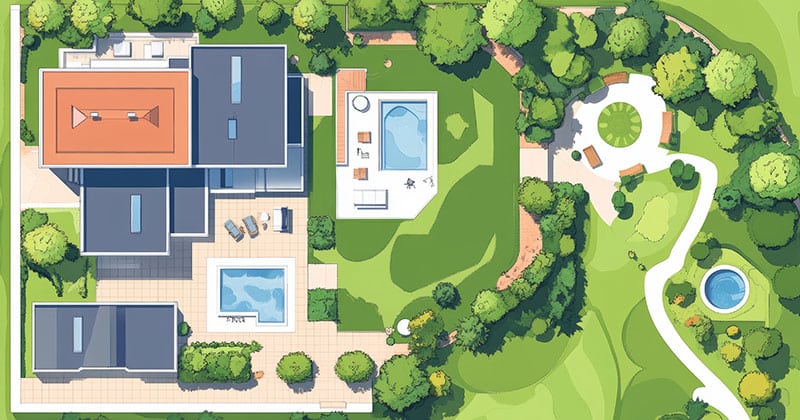The 8 Best Landscape Design Software Options
From simple design apps to robust 3D tools, this guide explores the best landscape design software for pros looking to streamline their workflow and impress clients.

Guest Contributor
In the world of landscaping, staying ahead means having more than great plants or clean layouts. It takes the right tools to design quickly, present clearly, and win more jobs.
You might be reimagining a backyard. Or sketching out a new commercial install. Maybe you just want to speed up your proposal process. The right software can help you do more with less hassle.
Think of this guide as your digital toolkit. We’ll walk you through the top landscape design software options on the market—each one tested and trusted by pros like you.
Let’s dig in.
The Best Landscape Design Software Tools
Let’s walk through some of the most popular landscape planning software options for professionals. Each one has different strengths, pricing structures, and learning curves.
We’ve outlined key features, pros and cons, and best-use cases so you can find a fit that works for your team and your goals.
Realtime Landscaping Pro
Realtime Landscaping Pro is a great choice for businesses that want fast, polished visuals without the complexity of CAD programs. Its drag-and-drop interface is simple to use, and the 3D walkthroughs are great for client presentations.
Key Features:
- 2D and 3D design
- Drag-and-drop interface
- Water feature and terrain design
- Photo-based design overlays
- One-time purchase
Pros:
✓ Easy to learn
✓ No subscription needed
✓ Ideal for quick mockups
Cons:
✗ Windows-only
✗ Not ideal for complex, scaled plans
Best For: Small teams and visual sales presentations
DynaScape
DynaScape is one of the most trusted names in professional landscape design—and for good reason. This software is built specifically for landscape businesses, offering both CAD-style design tools and business management features.
Key Features:
- Precise 2D CAD design interface
- Color rendering and 3D modeling
- Built-in plant database and material library
- Estimating and job management integration
- Mobile-friendly companion tools
Pros:
✓ Made specifically for landscape pros
✓ Detailed, professional-grade output
✓ Includes business tools beyond design
Cons:
✗ High price point
✗ Requires training to master (for Design product)
Best For: High-end firms and design-build contractors
SketchUp
SketchUp isn’t designed exclusively for landscape work, but its 3D modeling power and flexibility make it a favorite among design pros in many industries.
Key Features:
- Fully customizable 3D modeling
- Library of extensions and plug-ins
- Cloud sync with Trimble
- Integration with other design tools
Pros:
✓ Very flexible
✓ Broad support and tutorials
✓ Great for concept modeling
Cons:
✗ Not landscape-specific
✗ Learning curve can be steep
Best For: Designers who want creative freedom
VizTerra by Structure Studios
VizTerra brings your design to life with real-time 3D rendering and beautiful visuals. It’s a favorite for teams that prioritize high-impact presentations and want to wow their clients from the first meeting.
Key Features:
- Instant plan-to-video rendering
- Drag-and-drop design interface
- Extensive library of plants, materials, and furnishings
- Real-time terrain and lighting changes
Pros:
✓ Stunning visuals
✓ Great for closing sales
✓ User-friendly interface
Cons:
✗ Monthly subscription required
✗ Windows only
Best For: Sales-focused design pros

PRO Landscape+
PRO Landscape+ offers a great mix of 2D and 3D tools, plus a mobile app for working in the field. It’s especially useful for those who want photo-based mockups as well as traditional plan views.
Key Features:
- Drag-and-drop photo imaging
- 2D CAD-style design
- Integrated pricing tools
- Includes mobile and tablet apps
Pros:
✓ Combines photo-realism with technical plans
✓ Good for client-facing visuals
✓ Strong mobile access
Cons:
✗ Dated interface
✗ One-time cost can be high
Best For: Design-build companies and client presentations
AutoCAD LT
AutoCAD LT is an industry standard for 2D drafting, especially for those already familiar with CAD workflows. While not landscape-specific, it’s great for technical documentation.
Key Features:
- Precision 2D drafting tools
- Compatible with AutoCAD extensions
- Cloud storage with Autodesk
Pros:
✓ Trusted and stable
✓ Highly accurate
✓ Cross-functional use
Cons:
✗ No 3D modeling
✗ Learning curve for new users
Best For: Contractors and architects working with engineers
SmartDraw
SmartDraw offers a web-based alternative for pros who want a lightweight, easy-to-use option. It’s not built specifically for landscaping but includes templates and libraries that work well for outdoor planning.
Key Features:
- Cloud-based design
- Collaboration tools
- Templates for decks, patios, and landscaping
Pros:
✓ Works on any device
✓ Fast and intuitive
✓ Affordable
Cons:
✗ Limited depth for advanced projects
✗ Not built specifically for landscapers
Best For: Solopreneurs or quick proposal sketches
Land F/X
Land F/X is a powerful add-on for AutoCAD users. It brings landscape-specific tools like irrigation planning, planting schedules, and detail libraries to the AutoCAD environment.
Key Features:
- Built on AutoCAD
- Plant, hardscape, and irrigation tools
- Project management features
- Revit and SketchUp integrations
Pros:
✓ Deep feature set
✓ Ideal for large-scale planning
✓ Excellent support
Cons:
✗ Requires AutoCAD license
✗ Best for experienced users
Best For: Landscape architects and large firms

8 Key Features to Look for in Landscape Design Software
Not all landscape design software is built the same. And not every business needs the same features. But if you’re a small to midsize landscaping company looking to streamline your workflow and impress clients, a few features make all the difference.
Let’s break them down.
2D and 3D Design Tools
As a landscaper, you’ll likely want software that does both 2D and 3D design. 2D plans are essential for accuracy and permitting, while 3D designs are how you wow your clients.
Clear visuals help close deals faster because they eliminate the guesswork. Clients see exactly what they’re getting before the first shovel hits the ground.
Plant and Material Libraries
The more detailed your library, the faster you can build your designs.
Pre-loaded trees, shrubs, hardscapes, and lighting features save you time and make your plans feel polished and realistic. Bonus points if the materials reflect what’s actually available in your region.
Easy-to-Learn Interfaces
If your team can’t figure it out quickly, it’s not the right fit.
The best tools don’t require a tech background to get started. Look for a platform that allows your team to design without a month-long training session.
Photo Imaging Capabilities
Photo-based design tools let you take a picture of a real property and overlay your design directly on top.
It’s a powerful way to give clients a “before and after” preview, and it keeps things grounded in the real world.
Mobile and Cloud Access
Design doesn’t just happen behind a desk. Software that lets you make changes in the field—on a tablet or mobile device—saves you the back-and-forth.
Bonus points if you can pull up plans during on-site walkthroughs or sales meetings.
Business Tool Integration
Designing is only one piece of the puzzle. Look for software that links to your estimating, scheduling, or proposal systems. The less double entry, the better.
Some platforms even generate quotes directly from your design—turning ideas into jobs in just a few clicks.
Collaboration and Sharing Options
If you’re working with a crew or presenting to clients, you’ll want tools that make sharing your work simple.
Whether it’s client-facing previews or internal plan markups, collaboration shouldn’t be a separate app.
Scalability
Maybe you’re a solo contractor today, but you should plan to grow when you invest in your tools. So, make sure the software you choose can grow with you.
Look for tiered pricing, multi-user support, and business tools that won’t box you in later.
7 Tips for Choosing the Right Landscape Design Software
Finding the right software involves more than just features—it’s about fit. The best tools won’t just help you design better. They’ll help your entire business run smoother.
Before you buy a new platform, here’s what to think through.
Match It to Your Projects
You probably don’t need full-scale CAD drafting tools if you’re primarily working on small residential properties. But you’ll need that precision if you’re designing large commercial spaces or working with architects.
Pick a tool that aligns with the type—and size—of the projects you do most often. More power isn’t always better if you don’t need it.
Know Your Team’s Tech Comfort Level
A powerful platform is great until it becomes a bottleneck. If your team isn’t comfortable with complex software, you’re better off with something more intuitive. The goal is to speed things up, not create more work or frustration.
Think about who will be using the tool day to day and choose accordingly.
Consider Your Sales Process
If your business relies on fast turnarounds or strong visual presentations to close deals, look for tools with photo imaging or 3D rendering.
These features might not seem essential at first—but when your design can sell the job on its own, you’ll wonder how you ever lived without them.
Think Beyond the Design
You’re not just designing landscapes. You’re also estimating. Pitching. Scheduling installs.
If your design tool can link up with your business systems—or even handle some of that admin work for you—it can save hours every week. A solid integration can be the difference between chasing down paperwork and having everything in one place.
Shop with Growth in Mind
Even if you’re a one-person operation today, think ahead. Will this software support your business as it scales?
Look for tools that offer multiple pricing tiers, team collaboration, and features you can grow into. You don’t want to be back at square one in a year.
Check Support and Training Resources
The best tools come with real support, whether that’s video tutorials, live chat, or a strong user community.
If things go sideways or you want to improve faster, good support can make a huge difference.
Test Before You Commit
Most platforms offer free trials or live demos. Use them. Set up a test project. Import your existing workflow.
See how using a product feels in real time—not just how it looks in a marketing video. A good test run will tell you more than any feature list.

Next Steps for Choosing a Landscape Design Software
You’ve got the options. You know what to look for. Now, it’s time to make a move.
Here are 5 quick steps you can take today to start finding the right fit for your business:
1. Sign Up for a Free Trial
Most platforms offer a no-commitment trial. Take advantage of that.
Pick two or three tools that seem like a match and run a mini-project through each one. You’ll learn a lot just by clicking around.
2. Watch a Demo—The Full One
Don’t just skim through website videos. Look for real demos or webinars that show how the software works day-to-day.
It’s the fastest way to understand what using the tool actually looks like.
3. Read Reviews from Other Pros
Check out user feedback on sites like Capterra or G2.
Focus on reviews from companies that look like yours—same team size, same type of projects. Their pros and cons will tell you what to expect.
4. Talk to Your Team
If you’re not the only one using the software, get your team involved early. Ask what they’d want in a design tool and what features they need most.
This helps you buy once—and buy smart.
5. Map Your Process, Then Match the Software
Before you invest, sketch out your typical project flow—from the first client meeting to the final installation. Then, ask, “Will this software make each step faster or easier?”
If the answer’s yes across the board, you’re on the right track.
6. Ask About Support and Updates
A flashy demo is great, but what happens when you hit a snag? Reach out to the company’s support team and ask about training resources, live help, and how often they update the software.
Reliable software support can make or break your long-term success.
Choosing the right landscape design software isn’t just about features—it’s about finding a tool that works the way you do. Take the time to test your options, trust your process, and invest in a platform that helps your business look as sharp as the designs you deliver.
Jacob expertly crafts a range of content, from insightful blogs and guides to captivating narratives. In his downtime, he's either on the basketball court, running 5Ks, spiking volleyballs, or diligently penning chapters of his forthcoming book.

Business Solutions For Field Service Pros
EverPro offers specialized solutions designed for home and field service professionals. We’ve got the business tools to help you get the job done.



